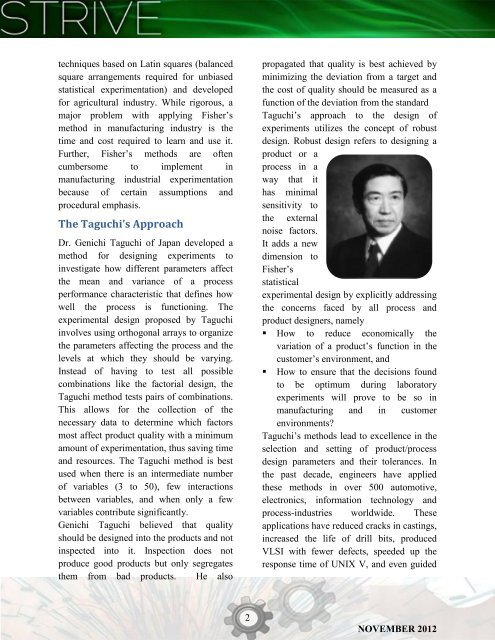sTRIVE final.pdf
Create successful ePaper yourself
Turn your PDF publications into a flip-book with our unique Google optimized e-Paper software.
techniques based on Latin squares (balanced<br />
square arrangements required for unbiased<br />
statistical experimentation) and developed<br />
for agricultural industry. While rigorous, a<br />
major problem with applying Fisher’s<br />
method in manufacturing industry is the<br />
time and cost required to learn and use it.<br />
Further, Fisher’s methods are often<br />
cumbersome to implement in<br />
manufacturing industrial experimentation<br />
because of certain assumptions and<br />
procedural emphasis.<br />
The Taguchi’s Approach<br />
Dr. Genichi Taguchi of Japan developed a<br />
method for designing experiments to<br />
investigate how different parameters affect<br />
the mean and variance of a process<br />
performance characteristic that defines how<br />
well the process is functioning. The<br />
experimental design proposed by Taguchi<br />
involves using orthogonal arrays to organize<br />
the parameters affecting the process and the<br />
levels at which they should be varying.<br />
Instead of having to test all possible<br />
combinations like the factorial design, the<br />
Taguchi method tests pairs of combinations.<br />
This allows for the collection of the<br />
necessary data to determine which factors<br />
most affect product quality with a minimum<br />
amount of experimentation, thus saving time<br />
and resources. The Taguchi method is best<br />
used when there is an intermediate number<br />
of variables (3 to 50), few interactions<br />
between variables, and when only a few<br />
variables contribute significantly.<br />
Genichi Taguchi believed that quality<br />
should be designed into the products and not<br />
inspected into it. Inspection does not<br />
produce good products but only segregates<br />
them from bad products. He also<br />
propagated that quality is best achieved by<br />
minimizing the deviation from a target and<br />
the cost of quality should be measured as a<br />
function of the deviation from the standard<br />
Taguchi’s approach to the design of<br />
experiments utilizes the concept of robust<br />
design. Robust design refers to designing a<br />
product or a<br />
process in a<br />
way that it<br />
has minimal<br />
sensitivity to<br />
the external<br />
noise factors.<br />
It adds a new<br />
dimension to<br />
Fisher’s<br />
statistical<br />
experimental design by explicitly addressing<br />
the concerns faced by all process and<br />
product designers, namely<br />
• How to reduce economically the<br />
variation of a product’s function in the<br />
customer’s environment, and<br />
• How to ensure that the decisions found<br />
to be optimum during laboratory<br />
experiments will prove to be so in<br />
manufacturing and in customer<br />
environments?<br />
Taguchi’s methods lead to excellence in the<br />
selection and setting of product/process<br />
design parameters and their tolerances. In<br />
the past decade, engineers have applied<br />
these methods in over 500 automotive,<br />
electronics, information technology and<br />
process-industries worldwide. These<br />
applications have reduced cracks in castings,<br />
increased the life of drill bits, produced<br />
VLSI with fewer defects, speeded up the<br />
response time of UNIX V, and even guided<br />
2<br />
NOVEMBER 2012







